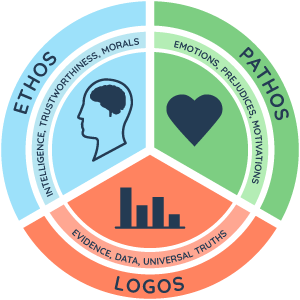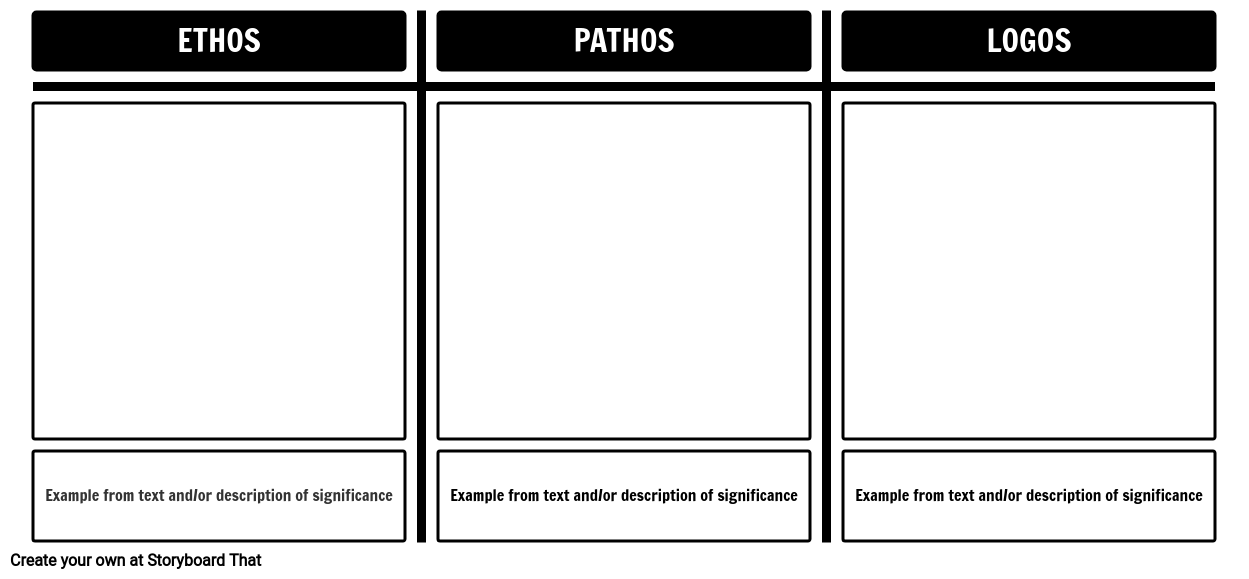Lesson Plan Overview
Ethos, Pathos, and Logos are elements of rhetoric which teach students how to write using strong persuasive skills. Aristotle was the first to coin the three methods that discuss the ways in which a person could use persuasion.
In the play, rhetoric is frequently used. Two most notable examples are uses to convince Brutus to join the conspirators and also when Antony speaks at Caesar’s funeral to backhandedly persuade the people of Rome to go against the conspirators.
Having students create storyboards that show examples of Ethos, Pathos, and Logos is a great way to introduce and teach basic rhetoric in the classroom!
Examples of Rhetoric in Antony’s Speech
Ethos/Expertise
“He was my friend, faithful and just to me.” Antony is justifying his words with the credibility of knowing Caesar. He is saying that he was always fair and just and that a true friend would know this.
Pathos/Appeal to Emotion
“This was the unkindest cut of them all.” Antony creates an emotional connection with the crowd. He makes them look at the stab wounds inflicted by Brutus, Caesar’s friend. With his words and actions, Antony creates feelings of pity, anguish, and distrust in the Roman citizens.
Logos/Logic
“He hath brought many captives home to Rome, Whose ransoms did the general coffers fill.” Throughout his speech, Antony gives examples of Caesar's generosity and humility as evidence that he was wrongly assassinated. This culminates in the reading of Caesar's will, which gives each citizen 75 Drachmas and half of his orchards. Antony uses this as evidence to logically prove that Caesar was not a tyrant.
Template and Class Instructions
(These instructions are completely customizable. After clicking "Copy Activity", update the instructions on the Edit Tab of the assignment.)
Student Instructions
Create a storyboard that shows examples of ethos, pathos, and logos from the text.
- Identify one example of each rhetorical strategy: ethos, pathos, and logos.
- Type the example into the description box under the cell.
- Illustrate the example using any combination of scenes, characters, and items.
Lesson Plan Reference
Student Rubric
(You can also create your own on Quick Rubric.)
| Proficient 33 Points | Emerging 25 Points | Beginning 17 Points | |
|---|---|---|---|
| Ethos, Pathos, and Logos | The elements of ethos, pathos, and logos are correctly identified and depicted, and an appropriate quote or summary is provided. There are at least 2 examples provided for each rhetorical element. | Most of the elements of ethos, pathos, and logos are correctly identified and depicted, and an appropriate quote or summary is provided. There are at least 2 examples provided for each rhetorical element. | The elements of ethos, pathos, and logos are incorrectly identified and depicted. Quotes and summaries may be missing or too limited. Only one example may have been provided for each rhetorical element. |
| Artistic Depictions | The art chosen to depict the scenes are accurate to the work of literature. Time and care is taken to ensure that the scenes are neat, eye-catching, and creative. | The art chosen to depict the scenes should be accurate, but there may be some liberties taken that distract from the assignment. Scene constructions are neat, and meet basic expectations. | The art chosen to depict the scenes is inappropriate. Scene constructions are messy and may create some confusion, or may be too limited. |
| English Conventions | Ideas are organized. There are few or no grammatical, mechanical, or spelling errors. | Ideas are mostly organized. There are some grammatical, mechanical, or spelling errors. | Ideas may be disorganized or misplaced. Lack of control over grammar, mechanics, and spelling reflect a lack of proofreading. |
Lesson Plan Overview
Ethos, Pathos, and Logos are elements of rhetoric which teach students how to write using strong persuasive skills. Aristotle was the first to coin the three methods that discuss the ways in which a person could use persuasion.
In the play, rhetoric is frequently used. Two most notable examples are uses to convince Brutus to join the conspirators and also when Antony speaks at Caesar’s funeral to backhandedly persuade the people of Rome to go against the conspirators.
Having students create storyboards that show examples of Ethos, Pathos, and Logos is a great way to introduce and teach basic rhetoric in the classroom!
Examples of Rhetoric in Antony’s Speech
Ethos/Expertise
“He was my friend, faithful and just to me.” Antony is justifying his words with the credibility of knowing Caesar. He is saying that he was always fair and just and that a true friend would know this.
Pathos/Appeal to Emotion
“This was the unkindest cut of them all.” Antony creates an emotional connection with the crowd. He makes them look at the stab wounds inflicted by Brutus, Caesar’s friend. With his words and actions, Antony creates feelings of pity, anguish, and distrust in the Roman citizens.
Logos/Logic
“He hath brought many captives home to Rome, Whose ransoms did the general coffers fill.” Throughout his speech, Antony gives examples of Caesar's generosity and humility as evidence that he was wrongly assassinated. This culminates in the reading of Caesar's will, which gives each citizen 75 Drachmas and half of his orchards. Antony uses this as evidence to logically prove that Caesar was not a tyrant.
Template and Class Instructions
(These instructions are completely customizable. After clicking "Copy Activity", update the instructions on the Edit Tab of the assignment.)
Student Instructions
Create a storyboard that shows examples of ethos, pathos, and logos from the text.
- Identify one example of each rhetorical strategy: ethos, pathos, and logos.
- Type the example into the description box under the cell.
- Illustrate the example using any combination of scenes, characters, and items.
Lesson Plan Reference
Student Rubric
(You can also create your own on Quick Rubric.)
| Proficient 33 Points | Emerging 25 Points | Beginning 17 Points | |
|---|---|---|---|
| Ethos, Pathos, and Logos | The elements of ethos, pathos, and logos are correctly identified and depicted, and an appropriate quote or summary is provided. There are at least 2 examples provided for each rhetorical element. | Most of the elements of ethos, pathos, and logos are correctly identified and depicted, and an appropriate quote or summary is provided. There are at least 2 examples provided for each rhetorical element. | The elements of ethos, pathos, and logos are incorrectly identified and depicted. Quotes and summaries may be missing or too limited. Only one example may have been provided for each rhetorical element. |
| Artistic Depictions | The art chosen to depict the scenes are accurate to the work of literature. Time and care is taken to ensure that the scenes are neat, eye-catching, and creative. | The art chosen to depict the scenes should be accurate, but there may be some liberties taken that distract from the assignment. Scene constructions are neat, and meet basic expectations. | The art chosen to depict the scenes is inappropriate. Scene constructions are messy and may create some confusion, or may be too limited. |
| English Conventions | Ideas are organized. There are few or no grammatical, mechanical, or spelling errors. | Ideas are mostly organized. There are some grammatical, mechanical, or spelling errors. | Ideas may be disorganized or misplaced. Lack of control over grammar, mechanics, and spelling reflect a lack of proofreading. |
How To Use Elements of Rhetoric in Creative Writing
Introduce the Elements of Rhetoric
Make simple and interesting introductions for the elements of rhetoric. Teachers can begin by using an example first and asking students why they think that the chosen text or writing was so persuasive. They can also begin the discussion by asking how to convince and persuade people in real life.
Choose a Topic
Ask the students to choose a topic where they will be persuading the rest of the class to agree with them. For example, topics such as “Video games are good for learning” or to convince the rest of the class to favor a disliked movie character.
Use Convincing Language
Encourage the students to use more convincing language to improve the credibility of their argument. Ask them to initially gain the trust of their class fellows and use their own experience to justify their position. To gain this trust, students can use wordplay and interesting use of phrases.
Make Emotional Connections
In order to convince the audience, students should make the argument more relatable for them and use their emotions to persuade them. Them step is particularly called Appeal to Emotion or Pathos.
Use More Facts
When people hear that an argument is statistically supported, they will be more convinced to accept it. Students can perform a little research on their argument beforehand and highlight some statistical facts and figures to prove their point.
Discuss and Reflect
After all the students are done presenting their arguments, evaluate how many of them succeeded in convincing their class fellows and reward them with words of motivation. Also, start a discussion on why the students were more convinced about some arguments as compared to others. Use these points to further elaborate the discussion on elements of rhetoric.
Frequently Asked Questions About Ethos, Pathos, and Logos in The Tragedy of Julius Caesar
How do Ethos, Pathos, and Logos fit into Antony's eulogy for Caesar?
An excellent illustration of Antony's deft use of these rhetorical arguments is in his eulogy for Caesar. Antony uses his reputation as Caesar's friend to reassure the audience that he has always been true to him. He emphasizes Caesar's kindness and the savagery of his assassination by using emotive language and images to elicit sentiments of pity and wrath from the audience. Antony demonstrates the rational justifications for backing Caesar's cause by presenting proof of Caesar's will and the advantages Caesar brought to Rome.
How do the play's ethos, pathos, logos, and themes of power and ambition connect to one another?
The utilization of these appeals is intimately related to the concepts of ambition and power. Ethos, Pathos, and Logos are used by characters to acquire and solidify power. Characters are motivated to use persuasion to persuade others and advance their goals through Caesar's ambition and their dread of his possible dictatorship.
More Storyboard That Activities
Tragedy of Julius Caesar, The
This Activity is Part of Many Teacher Guides
Testimonials

“By using the product, they were so excited and they learned so much...”–K-5 Librarian and Instructinal Technology Teacher

“I'm doing a Napoleon timeline and I'm having [students] determine whether or not Napoleon was a good guy or a bad guy or somewhere in between.”–History and Special Ed Teacher

“Students get to be creative with Storyboard That and there's so many visuals for them to pick from... It makes it really accessible for all students in the class.”–Third Grade Teacher
© 2025 - Clever Prototypes, LLC - All rights reserved.
StoryboardThat is a trademark of Clever Prototypes, LLC, and Registered in U.S. Patent and Trademark Office













